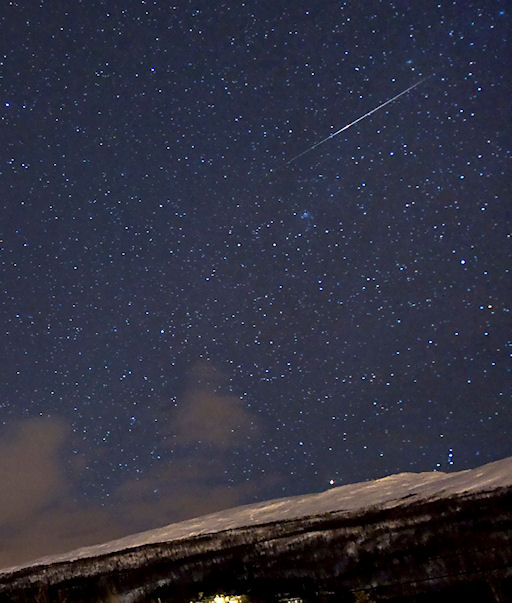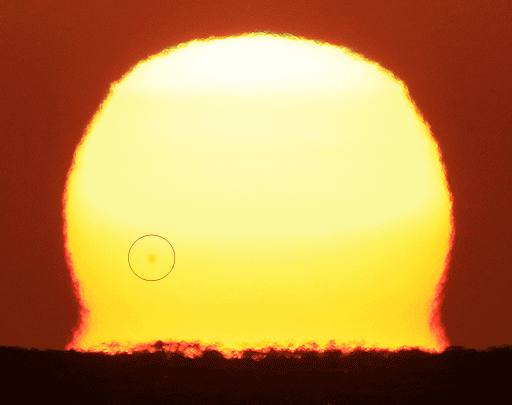AURORA ALERTS: Did you miss the Northern Lights? Next time get a wake-up call from Space Weather PHONE | | |
AURORA WATCH: High-latitude sky watchers should be alert for auroras on Dec. 10th and 11th when a solar wind stream is expected to hit Earth's magnetic field. NOAA forecasters estimate a 20%-50% chance of geomagnetic activity.
GEMINID METEOR SHOWER: This week, Earth is entering a stream of debris from asteroid 3200 Phaethon, source of the mysterious Geminid meteor shower. Although the shower's peak won't come until Dec. 13th and 14th, people are already seeing a smattering of bright shooting stars. Fredrik Broms photographed this Geminid streaking over the snowy hills of Kvaløya, Norway, on Dec. 7th:

Geminid meteor rates are low now, less than 5 to 10 per hour, but they will climb ten-fold early next week when Earth passes through a busier part of the debris stream. People who go outside between midnight and sunrise on Tuesday, Dec. 14th, could count as many as 120 Geminds per hour. Urban light pollution will reduce number of visible meteors by factors of 2 to 5, so get away from city lights if you can. A rural setting is best for meteor watching.
PLAN B: Got clouds? If you can't see the Geminids, you can listen to them instead on Space Weather Radio. We're transmitting live meteor echoes from the US Air Force Space Surveillance Radar in Kickapoo, Texas.
SUNSPOT SUNRISE: Sunspot 1131 is so big, it can be seen without the aid of a solar telescope. On Dec. 6th, Terry Reis "spotted" it while photographing the sunrise from White Plains Beach, Oahu, Hawaii:

Photo details: Canon 5D, Canon 600mm w/.025 extender, ISO 400, F8, 1/8000s
"Other than the sunspot, it was a completely routine Hawaiian sunrise," says Reis. "Beautiful!"
Sunspot 1131 is big, but quiet. The behemoth spot has a simple, stable magnetic field that poses little threat for a major eruption. At the moment it is producing more pretty pictures than solar flares. Browse the links, below, for examples.
more images: from Rogerio Marcon of Campinas SP Brasil; from John C McConnell of Maghaberry, Northern Ireland; from Theo Ramakers of Social Circle GA; from Monika Landy-Gyebnar of Veszprem, Hungary
WARNING: Even when the sun is dimmed by fog or low-hanging clouds, it can still damage your eyes. Do not stare directly at the sun or look at the sun through unfiltered optics. If you attempt to photograph a dim sun, do not look through the optical viewfinder. Instead, compose the scene using the camera's digital viewscreen.
November 2010 Aurora Gallery
[previous Novembers: 2009, 2008, 2007, 2006, 2004, 2003, 2002, 2001, 2000]
Potentially Hazardous Asteroids (
PHAs) are space rocks larger than approximately 100m that can come closer to Earth than 0.05 AU. None of the known PHAs is on a collision course with our planet, although astronomers are finding
new ones all the time.
On December 9, 2010 there were 1167 potentially hazardous asteroids.
Notes: LD means "Lunar Distance." 1 LD = 384,401 km, the distance between Earth and the Moon. 1 LD also equals 0.00256 AU. MAG is the visual magnitude of the asteroid on the date of closest approach. | | The official U.S. government space weather bureau |
| | The first place to look for information about sundogs, pillars, rainbows and related phenomena. |
| | Researchers call it a "Hubble for the sun." SDO is the most advanced solar observatory ever. |
| | 3D views of the sun from NASA's Solar and Terrestrial Relations Observatory |
| | Realtime and archival images of the Sun from SOHO. |
| | from the NOAA Space Environment Center |
| | the underlying science of space weather |

